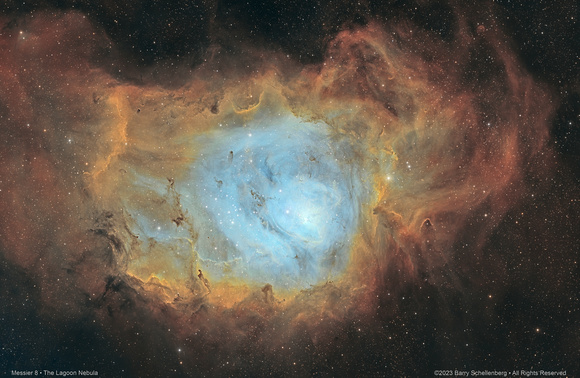Other Names: Sharpless 25, NGC 6523, Lagoon Nebula
Optics: Astro-Physics 305mm F/3.8 Riccardi-Honders Astrograph Mount: Paramount ME using
The SkyX Pro Camera: FLI ML16200 Filters: Chroma Ha 8nm, OIII 8nm, SII 8nm
Exposure: 820 Mins or 13 2/3 hours, [10x 1200s Ha, 15x 1200s OIII, 16x 1200s SII], Binned 1x1
Accessories: Auto guided with
SXAO & Starlight Xpress Lodestar.
FLI Atlas focuser using FMv4
Location: Southern, IN
Date: Taken over several nights from July 13th to July 23rd, 2023
Notes: Image acquisition with
TSXPro using
MaxPilote automation software.
All Processing completed using
PixInsight and the following steps:
- WBPP/DBE/Linear Fit/PixelMath SHO/BlurXT/StarXT/Multiscale Linear Transformation/NoiseXT/Color Masks/Histogram & Curves/Add Stars back using PixelMath/Background Neutralization/Crop
Calibrated w/18 Darks, 100 Bias, 10 Flats of each filter using a flat panel. CCD temperature was -20C. Image was taken from my backyard Observatory.
The
Lagoon Nebula (catalogued as
Messier 8 or
M8,
NGC 6523,
Sharpless 25,
RCW 146, and
Gum 72) is a giant
interstellar cloud in the
constellation Sagittarius. It is classified as an
emission nebula and as an
H II region.
The Lagoon Nebula was discovered by
Giovanni Hodierna before 1654
[5] and is one of only two star-forming
nebulae faintly visible to the eye from mid-northern latitudes. Seen with
binoculars, it appears as a distinct cloud-like patch with a definite core. Within the nebula is the
open cluster NGC 6530.
[6]


